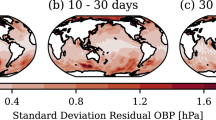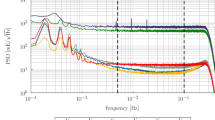Abstract
A realistically perturbed synthetic de-aliasing model consistent with the updated Earth System Model of the European Space Agency is now available over the period 1995–2006. The dataset contains realizations of (1) errors at large spatial scales assessed individually for periods 10–30, 3–10, and 1–3 days, the S1 atmospheric tide, and sub-diurnal periods; (2) errors at small spatial scales typically not covered by global models of atmosphere and ocean variability; and (3) errors due to physical processes not represented in currently available de-aliasing products. The model is provided in two separate sets of Stokes coefficients to allow for a flexible re-scaling of the overall error level to account for potential future improvements in atmosphere and ocean mass variability models. Error magnitudes for the different frequency bands are derived from a small ensemble of four atmospheric and oceanic models. For the largest spatial scales up to \(\hbox {d/o} = 40\) and periods longer than 24 h, those error estimates are approximately confirmed from a variance component estimation based on GRACE daily normal equations. Future mission performance simulations based on the updated Earth System Model and the realistically perturbed de-aliasing model indicate that for GRACE-type missions only moderate reductions of de-aliasing errors can be expected from a second satellite pair in a shifted polar orbit. Substantially more accurate global gravity fields are obtained when a second pair of satellites in an moderately inclined orbit is added, which largely stabilizes the global gravity field solutions due to its rotated sampling sensitivity.










Similar content being viewed by others
References
Baldauf M, Seifert A, Förstner J, Majewski D, Raschendorfer M, Reinhardt T (2011) Operational convective-scale numerical weather prediction with the COSMO Model: description and Sensitivities. Mon Weather Rev 139:3887–3905. doi:10.1175/MWR-D-10-05013.1
Bergmann I, Dobslaw H (2012) Short-term transport variability of the Antarctic Circumpolar Current from satellite gravity observations. J Geophys Res 117(C5):1–12. doi:10.1029/2012JC007872
Bergmann-Wolf I, Forootan E, Klemann V, Kusche J, Dobslaw H (2015) Updating ESA’s Earth System Model for Gravity Mission Simulation Studies: 3. A Realistically Perturbed Non-Tidal Atmosphere and Ocean De-Aliasing Model, Tech. rep., Scientific Technical Report 14/09, GFZ. doi:10.2312/GFZ.b103-14091
Boy J-P (2005) Precise evaluation of atmospheric loading effects on Earth’s time-variable gravity field. J Geophys Res 110(B8):1–10. doi:10.1029/2002JB002333
Carrère L, Lyard F (2003) Modeling the barotropic response of the global ocean to atmospheric wind and pressure forcing—comparisons with observations. Geophys Res Lett 30(6):1997–2000. doi:10.1029/2002GL016473
Chambers DP (2004) Preliminary observations of global ocean mass variations with GRACE. Geophys Res Lett 31(13):1–4. doi:10.1029/2004GL020461
Dee DP et al (2011) The ERA-Interim reanalysis: configuration and performance of the data assimilation system. Q J R Meteorol Soc 137(656):553–597. doi:10.1002/qj.828
Dobslaw H, Thomas M (2007) Simulation and observation of global ocean mass anomalies. J Geophys Res 112(C5), C05,040. doi:10.1029/2006JC004035
Dobslaw H, Flechtner F, Bergmann-Wolf I, Dahle C, Dill R, Esselborn S, Sasgen I, Thomas M (2013) Simulating high-frequency atmosphere-ocean mass variability for dealiasing of satellite gravity observations: AOD1B RL05. J Geophys Res 118(7):3704–3711. doi:10.1002/jgrc.20271
Dobslaw H, Bergmann-Wolf I, Dill R, Forootan E, Klemann V, Kusche J, Sasgen I (2015) The updated ESA Earth System Model for future gravity mission simulation studies. J Geod doi:10.1007/s00190-014-0787-8
Duan J, Shum CK, Guo J, Huang Z (2012) Uncovered spurious jumps in the GRACE atmospheric de-aliasing data: potential contamination of GRACE observed mass change. Geophys J Int 2:1–5. doi:10.1111/j.1365-246X.2012.05640.x
Elsaka B, Raimondo J-C, Brieden P, Reubelt T, Kusche J, Flechtner F, Iran Pour S, Sneeuw N, Müller J (2014) Comparing seven candidate mission configurations for temporal gravity field retrieval through full-scale numerical simulation. J Geod 88(1):31–43. doi:10.1007/s00190-013-0665-9
Famiglietti JS, Rodell M (2013) Water in the balance. Science (80-. ) 340(61):1300–1301. doi:10.1126/science.1236460
Flechtner F, Dobslaw H (2013) GRACE AOD1B Product Description Document for Product Release 05. Tech. rep., Rev. 4.0, GRACE Document 327–750, GeoForschungsZentrum Potsdam
Flechtner F, Morton P, Watkins M, Webb F (2014) Status of the GRACE Follow-On Mission. In: Marti U (ed) IAG Symposium Gravity, Geoid, Height System International Association Geodesy Symposium 141. Springer, doi:10.0007/978-3-319-10837-7-15
Flechtner F, Neumayer K-H, Dahle C, Dobslaw H, Güntner A, Raimondo J-C, Fagiolini E (2015) What can be expected from the GRACE-FO Laser Ranging Interferometer for Earth Science Applications? Surv Geophys. doi:10.1007/s10712-015-9338-y
Forootan E, Didova O, Kusche J, Löcher A (2013) Comparisons of atmospheric data and reduction methods for the analysis of satellite gravimetry observations. J Geophys Res 118(1):2382–2396. doi:10.1002/jgrb.50160
Forootan E, Didova O, Schumacher M, Kusche J, Elsaka B (2014) Comparisons of atmospheric mass variations derived from ECMWF reanalysis and operational fields, over 2003–2011. J Geod 88:503–514. doi:10.1007/s00190-014-0696-x
Gruber T et al (2011) Simulation of the time-variable gravity field by means of coupled geophysical models. Earth Syst Sci Data 3(1):19–35. doi:10.5194/essd-3-19-2011
Gruber T et al (2014) Earth System Mass Transport Mission (Square)? Concept for a Next Generation Gravity Field Mission, 318. Deutsche Geodätische Komission, Series B, Bayerische Akademie der Wissenschaften, Munich, pp 210
Han S-C, Jekeli C, Shum CK (2004) Time-variable aliasing effects of ocean tides, atmosphere, and continental water mass on monthly mean GRACE gravity field. J Geophys Res 109(4): B04,403. doi:10.1029/2003JB002501
Kim J (2000) Simulation study of a low-low satellite-to-satellite tracking mission, Ph.d. thesis, University of Texas, Austin
Koch KR, Kusche J (2002) Regularization of geopotential determination from satellite data by variance components. J Geod 76(5):259–268. doi:10.1007/s00190-002-0245-x
Kuhlmann J, Dobslaw H, Petrick C, Thomas M (2013) Ocean bottom pressure signals around Southern Africa from in situ measurements, satellite data, and modeling. J Geophys Res 118(10):4889–4898. doi:10.1002/jgrc.20372
Kurtenbach E, Mayer-Gürr T, Eicker A (2009) Deriving daily snapshots of the Earth’s gravity field from GRACE L1B data using Kalman filtering. Geophys Res Lett 36(L17):102. doi:10.1029/2009GL039564
Kurtenbach E, Eicker A, Mayer-Gürr T, Holschneider M, Hayn M, Fuhrmann M, Kusche J (2012) Improved daily GRACE gravity field solutions using a Kalman smoother. J Geod 59–60:39–48. doi:10.1016/j.jog.2012.02.006
le Bars Y, Lyard F, Jeandel C, Dardengo L (2010) The AMANDES tidal model for the Amazon estuary and shelf. Ocean Model 31(3–4):132–149. doi:10.1016/j.ocemod.2009.11.001
Loomis BD, Nerem RS, Luthcke SB (2011) Simulation study of a follow-on gravity mission to GRACE. J Geod 86(5):319–335. doi:10.1007/s00190-011-0521-8
Mayer-Gürr T, Zehentner N, Klinger B, Kvas A (2014) ITSG-Grace2014: A new GRACE gravity field release computed in Graz. In: Procedings of GRACE Science Team Meet, Potsdam
Menemenlis D, Campin J-M (2008) ECCO2: High resolution global ocean and sea ice data synthesis. Mercat Ocean Newsl 1(10):13–21
Panet I et al (2012) Earth system mass transport mission (e.motion): a concept for future earth gravity field measurements from space. Surv Geophys 34(2):141–163. doi:10.1007/s10712-012-9209-8
Rienecker MM et al (2011) MERRA: NASA’s modern-era retrospective analysis for research and applications. J Clim 24:3624–3648. doi:10.1175/JCLI-D-11-00015.1
Saha S et al (2010) The NCEP climate forecast system reanalysis. Bull Am Meteorol Soc 91(August):1015–1057. doi:10.1175/2010BAMS3001.1
Sakumura C, Bettadpur S, Bruinsma S (2014) Ensemble prediction and intercomparison analysis of GRACE time-variable gravity field models. Geophys Res Lett 1389–1397. doi:10.1002/2013GL058632.1
Sasgen I, Konrad H, Ivins ER, Van Den Broeke MR, Bamber JL, Martinec Z, Klemann V (2013) Antarctic ice-mass balance 2003 to 2012: Regional reanalysis of GRACE satellite gravimetry measurements with improved estimate of glacial-isostatic adjustment based on GPS uplift rates. Cryosphere 7:1499–1512. doi:10.5194/tc-7-1499-2013
Tapley BD, Bettadpur S, Watkins M, Reigber C (2004) The gravity recovery and climate experiment: Mission overview and early results. Geophys Res Lett 31(22): 09,607. doi:10.1029/2004GL019920
Thomas M, Sündermann J, Maier-Reimer E (2001) Consideration of ocean tides in an OGCM and impacts on subseasonal to decadal polar motion. Geophys Res Lett 28(12):2457–2460
Thompson PF (2004) Impact of short period, non-tidal, temporal mass variability on GRACE gravity estimates. Geophys Res Lett 31(6). doi:10.1029/2003GL019285
Uppala SM et al (2005) The ERA-40 re-analysis. Q. J. R. Meteorol. Soc. 131(612):2961–3012. doi:10.1256/qj.04.176
van Dam T, Altamimi Z, Collilieux X, Ray J (2010) Topographically induced height errors in predicted atmospheric loading effects. J Geophys Res 115(B7):B07,415. doi:10.1029/2009JB006810
Visser PNAM (2010) Designing Earth gravity field missions for the future: a case study. In: IAG Comm. 2 GRAVITY, GEOID EARTH Obs. Chania, pp 131–138
von Storch J-S, Eden C, Fast I, Haak H, Hernández-Deckers D, Maier-Reimer E, Marotzke J, Stammer D (2012) An estimate of the lorenz energy cycle for the world ocean based on the STORM/NCEP simulation. J Phys Ocean 42(12):2185–2205. doi:10.1175/JPO-D-12-079.1
Wiese DN, Folkner WM, Nerem RS (2009) Alternative mission architectures for a gravity recovery satellite mission. J Geod 83:569–581. doi:10.1007/s00190-008-0274-1
Wiese DN, Nerem RS, Lemoine FG (2012) Design considerations for a dedicated gravity recovery satellite mission consisting of two pairs of satellites. J Geod 86:81–98. doi:10.1007/s00190-011-0493-8
Zenner L, Gruber T, Jäggi A, Beutler G (2010) Propagation of atmospheric model errors to gravity potential harmonics-impact on GRACE de-aliasing. Geophys J Int 182(2):797–807. doi:10.1111/j.1365-246X.2010.04669.x
Zenner L, Bergmann-Wolf I, Dobslaw H, Gruber T, Güntner A, Wattenbach M, Esselborn S, Dill R (2014) Comparison of Daily GRACE Gravity Field and Numerical Water Storage Models for De-aliasing of Satellite Gravimetry Observations. Surv Geophys. doi:10.1007/s10712-014-9295-x
Acknowledgments
We thank three anonymous reviewers and the Editor, Pavel Ditmar, for their insightful comments and suggestions that greatly helped to improve our manuscript. This study was performed under contract No. 4000109421 with the European Space Agency. We thank Deutscher Wetterdienst, Offenbach, Germany, and the European Centre for Medium-Range Weather Forecasts for providing data from ECMWF’s latest re-analysis ERA-Interim. Numerical simulations were performed at Deutsches Klimarechenzentrum, Hamburg, Germany. The updated Earth System Model and the corresponding realistically perturbed AOD model as described in this paper are publicly available at doi:10.5880/GFZ.1.3.2014.001.
Author information
Authors and Affiliations
Corresponding author
Rights and permissions
About this article
Cite this article
Dobslaw, H., Bergmann-Wolf, I., Forootan, E. et al. Modeling of present-day atmosphere and ocean non-tidal de-aliasing errors for future gravity mission simulations. J Geod 90, 423–436 (2016). https://doi.org/10.1007/s00190-015-0884-3
Received:
Accepted:
Published:
Issue Date:
DOI: https://doi.org/10.1007/s00190-015-0884-3




